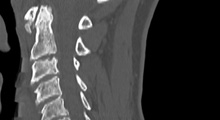
CT
Seeing Inside the Body
CT (computerized tomography) is a fast and easy process to look within the body to see the structure of bone, and soft tissue. For many physicians, this is the procedure of choice to see detailed images of the abdomen or other major organs of the body. It is also used in conjunction with a myelogram for enhanced spinal diagnoses.
The CT Scan can help diagnose abnormalities in nearly any body organ. This is helpful in identifying conditions such as blood clots, internal bleeding, skull fractures, inflamed sinuses, appendicitis, kidney stones or problems with the back, bones, lungs or colon.
At CRL Imaging, Radiologists and Technologists perform CT Scans and myelograms (special views of the spinal canal) to provide the best imaging possible to help people heal with greater comfort, fewer complications, less risk and better results. A physician’s referral is required.
About the Procedure
CT (computerized tomography) is actually an x-ray procedure that uses a computer to form the images. In a traditional x-ray, dense tissue can block other areas. In a CT scan, several cross-sections are put together by the computer to generate a two-dimensional cross-section, or “slice” of the body, which clearly shows soft tissue and bone.
Preparation
If you are having an abdominal or pelvic scan, you may be asked to:
• Not eat or drink two hours before the scan.
• Drink an oral contrast 90 minutes before your scan. This will highlight the stomach wall and large and small intestines, providing better detail.
• If any medications are needed, take them with a small amount of water or food.
For other scans, preparation may or may not be necessary. Check with the Imaging Center for specific instructions related to your exam.
Please let us know if you have any of the following medical conditions:
- Allergies
- Asthma
- Kidney problems
- Diabetes
- Pregnancy – known or possible
- Previous reactions to iodinated contrast (IVP or CT dye)
During the Procedure
The CT scan can take several minutes, depending on the scan type. Expect the process to take 15 to 45 minutes.
You will be asked to lie on a table that slides into the large donut-like opening of the CT scanner. The part of your body being scanned will be in the center of the opening. The technologist will be able to see and hear you at all times during the scanning.
Depending on the type of CT scan, contrast may be administered by placement of an IV into the arm or hand. This contrast will make blood vessels, organs, and any abnormalities show more clearly. After the contrast is injected you may feel a warm sensation throughout your body. This is normal and passes in about a minute.
After the Procedure
If given IV contrast, drink extra fluids (water, fruit juice, or decaffeinated beverages) to help flush the contrast from your system. You may resume normal activities.
Follow-up
A board-certified Radiologist from CRL Imaging will interpret the scan and relate their findings to the referring physician, who will in turn inform you of the results. All written reports will be available to the referring physician within 24 hours. Any finding needing immediate attention will be called to the referring physician the day of the exam.
